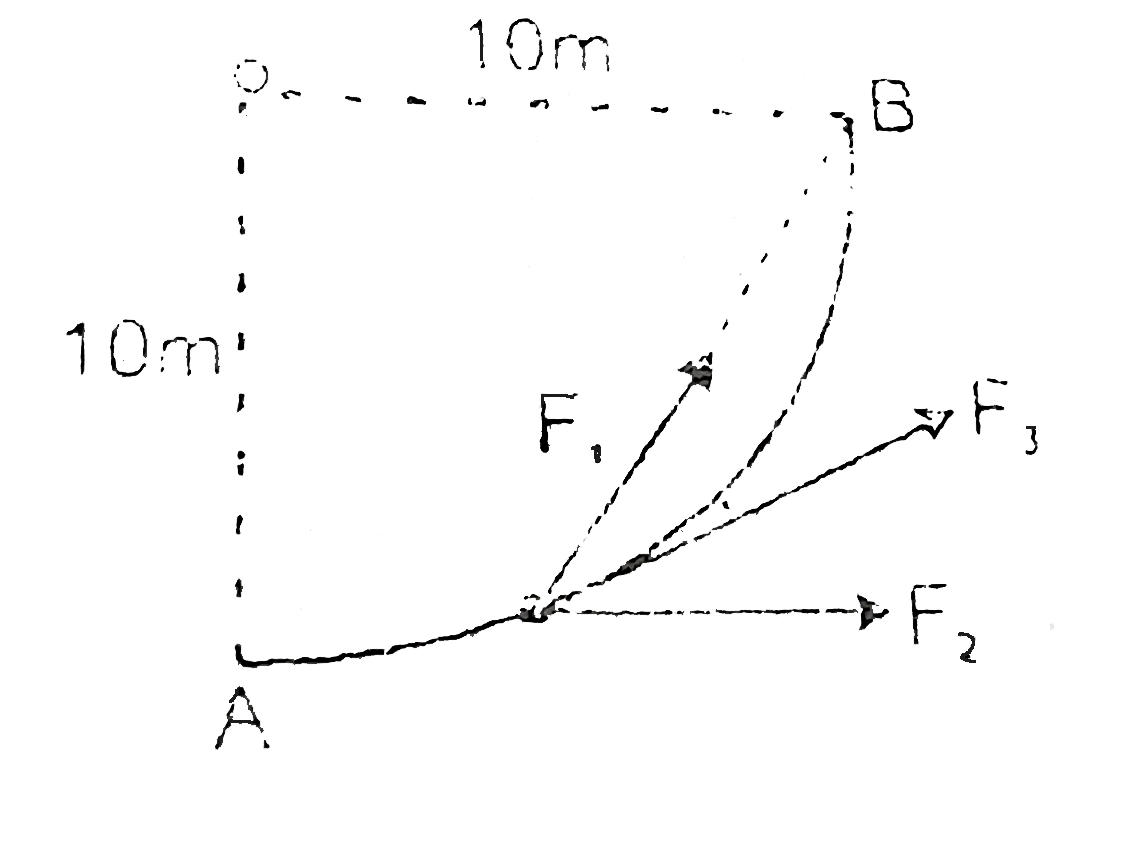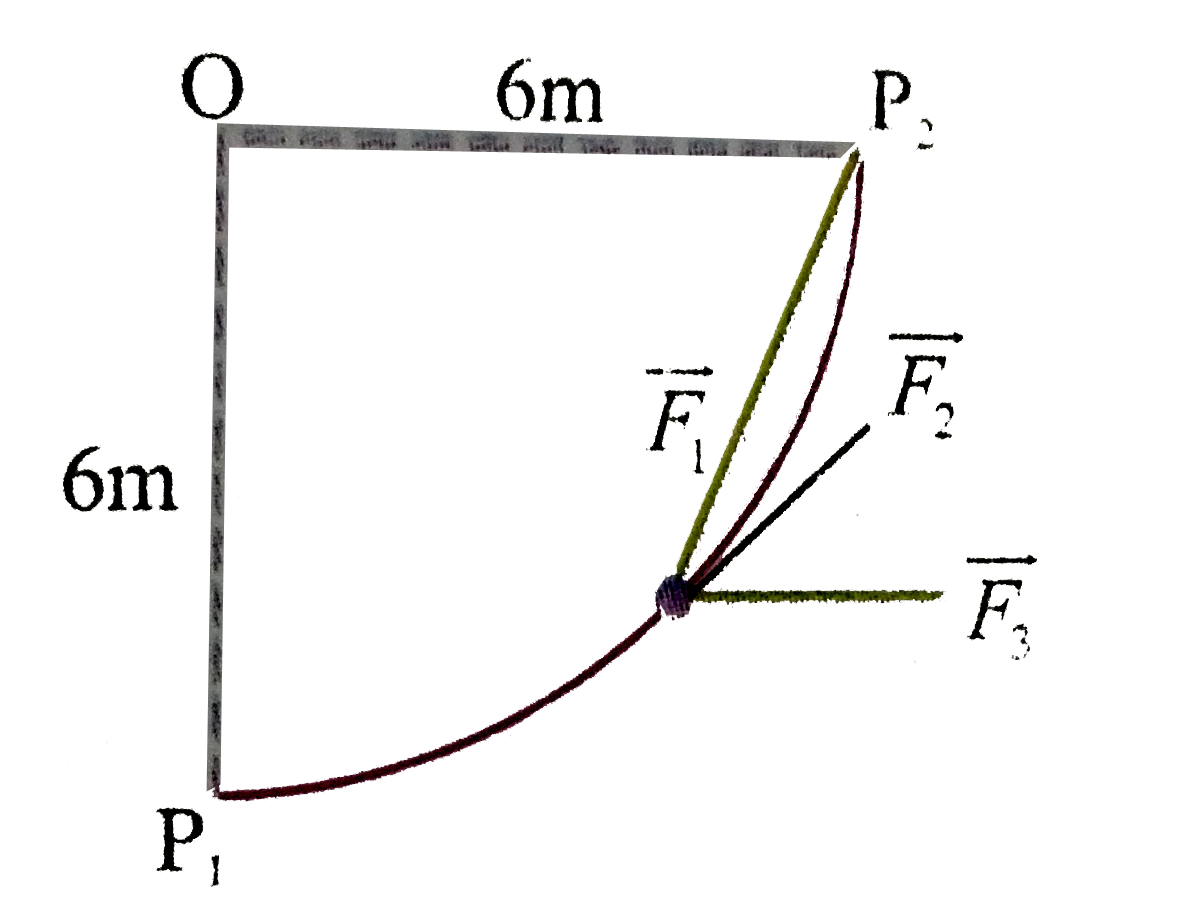A smooth track is in the form of a quarter circle of radius 10 m lies in the vertical plane. A bead moves from A and B along the circular track under the action of forces →F1,→F2 and →F3 Force →F1 acts always towards point B and is always 20 N in magnitude Force →F2 always acts horizontally and is always 25 N in magnitude. Force →F3 always acts tangentially to the track and is of constant magnitude 10 N. Select the correct answer.

Work done by →F1 is 750 J on the bead
Work done by →F2 is 20 J on the bead
Work done by →F3 is 50πJ on the bead
Work done by →F3 is 100√2Jon the bead
The correct Answer is:B, C
Work done by F1=20×10√2=200√2J
Work done F2=25×10=250J
Work done by F3=10×2πR4=50πJ.
Topper's Solved these Questions
- DAILY PRACTICE PROBLEMBOOK - RESONANCECHAPTER - DAILY PRACTICE PROBLEMEXERCISE - DPP No.53
20 Videos
- DAILY PRACTICE PROBLEMBOOK - RESONANCECHAPTER - DAILY PRACTICE PROBLEMEXERCISE - DPP No.54
9 Videos
- DAILY PRACTICE PROBLEMBOOK - RESONANCECHAPTER - DAILY PRACTICE PROBLEMEXERCISE - DPP No.51
20 Videos
- CURRENT ELECTRICITYBOOK - RESONANCECHAPTER - CURRENT ELECTRICITYEXERCISE - High Level Problems (HIP)
21 Videos
- ELECTRO MAGNETIC WAVESBOOK - RESONANCECHAPTER - ELECTRO MAGNETIC WAVESEXERCISE - Exercise 3
27 Videos
Similar Questions
A smooth track in the form of a quarter-circle of radius 6 m lies in the vertical plane. A ring of weight 4(N) moves from P1 and P2 under the action of forces F1,F2 and F3. is always towards P2 under the action of forces F1,F2 and F3 Force F1 is always towards P2 and is always (20) N in maghitude, force F2 always acts hotizontally and is always (30 N) in magnitude, force F3 always acts tangentially to the track and is of magnitude (15−10s)N, where s is in metre. If the particle has speed 4m/s at P1,what will its speed be at P2?
View SolutionWhich of the figure's six arrangements correctly show the vector addition of forces →F1 and →F2 to yield the third vector, which is meant to represent their net force →Fnet ?

View Solution
Knowledge Check
A smooth track in the form of a quarter circle of radius 6m lies in the vertical plane. A particle moves from P1 to P2 under the action of forces →F1,→F2 and →F3 Force →F1 is 20N, Force →F2 is always 30N in magnitude. Force →F3 always acts tangentiallly to the track and is of magnitude 15N. Select the correct alternative (s) :
 .AWork done by →F1 is 120JBWork done by →F2 is 180JCWork done by →F3 is 45πJD→F1 is conservative in nature.
.AWork done by →F1 is 120JBWork done by →F2 is 180JCWork done by →F3 is 45πJD→F1 is conservative in nature.Two forces −→F1and−→F2 are acting at right angles to each other , find their resultant ?
A√F21−F22B√F21+F22C√(F1+F2)DF1+F2Three forces →F1,→F2 and →F3 are represented as shown. Each of them is equal magnitude.

Now match the given columns and select the correct option from the codes given below.Ai-p,ii-q,iii-r,iv-sBi-s,ii-r,iii-q,iv-pCi-q,ii-r,iii-p,iv-sDi-r,ii-s,iii-p,iv-q
A body of mass m has an initial speed v is acted by two forces →F1 and →F2. After something work done by →F1 is −12mv2 and speed of the body is 2v. Then, the work done by →F2 is
View SolutionA body is at rest under the action of three forces, two of which are →F1=4ˆi,→F2=6ˆj, the third force is
View SolutionWhen force →F1,→F2,→F3 are acting on a particle of mass m, the particle remains in equilibrium. If the force →F1 is now removed then the acceleration of the particle is :
View SolutionA particle moves along a curve of unknown shape but magnitude of force F is constant and always acts along tangent to the curve.Then
View SolutionThe figure shows a ring in which a square is inscribed. Four equal forces →F1,→F2,→F3,→F4 of magnitude 10N each act at A, B, C, D. Two force F5 and F6 of magnitude 10√2N each act at A and B. The ring will

View Solution
